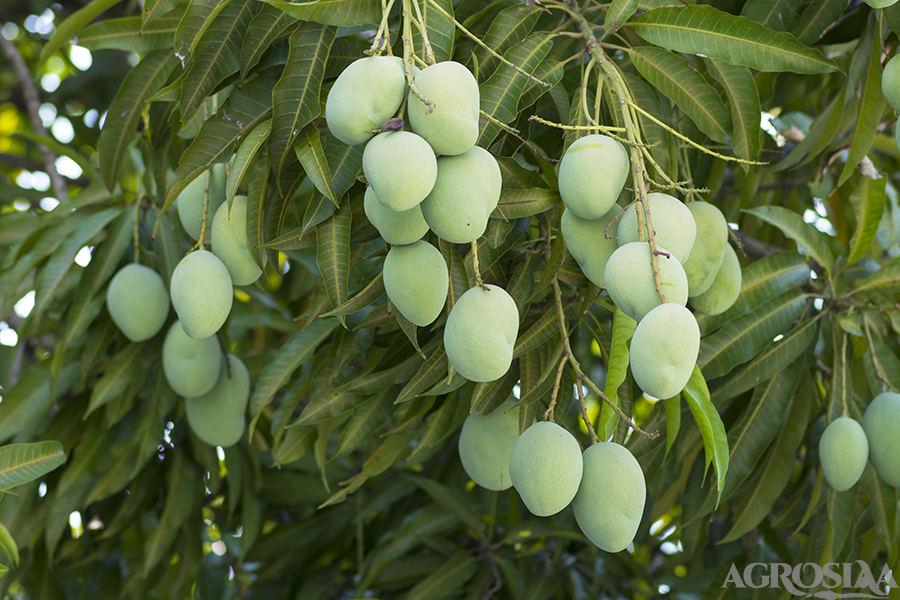Amba
Anacardiaceae
Mangifera indica
Improved varieties- Neelam, Dasheri-51, Keshar, Totapuri, Sweet , Haden, and Alophanso Hybrids- Sai Sugandh, Ratna, Sindhu, Konkan Ruchi, Mallika, Amrapali, Arka Puneet, Arka Neelkiran, Neelphanso, Neeleshan G J, and Prabhashankar
Kharif season for planting
Mango can be grown under both tropical and sub tropical climate from sea level to 1400 m altitude provided there is no high humidity, rain or frost during flowering period. Places with good rainfall and dry summer are ideal for mango cultivation. It is better to avoid areas with winds and cyclones which may cause flower and fruit shedding and breaking of branches.
Mango can grows on wide range of soils from alluvial to laterite prodided they are deep and well drained. It prefers slightly acidic soils. (pH range shuld be between 5.5 to 7.5)
Land should be prepared by deep ploughing followed by harrowing and levelling with a gentle slope for good drainage. Pit size requaried 1m x 1m x 1m. Pits are filled with original soil mixed with 20-25 kg well rotten FYM 2.5 kg single super phosphate and 1 kg muriate of potash.
-
-
Grafts plants of mango planting in pits.
Proper season for planting in kharif (June-July)
In heavy soil spacing should be kept 10 m x 10 m and medium soil 9 x 9 m
In 1 m x 1m x 1 m size pits one year old healthy straight growing grafts from reliable sources can be planted at the centre of pits along with the ball of the earth intack during rainy season. Roots are not expanded and the graft union is above the ground level. Plants should be irrigated immediately after planting. Provide some shade to the young plants.
In general 170- gm urea, 110 gm single super phosphate and 115 gm muriate of potash per plant per year and then 1.7 kg, 1.1 kg and 1.15 kg fertilizer per plant per year. N can be applied in two equal doses first in June - July and second October. Foliar spray of 3 % urea before flowering in sandy soil.
Young plants are watered frequently for proper establishment. Irrigation at 10 to 15 days interval from fruit set to maturity for improving yield. Irrigation is not recommended for 2-3 months prior to flowering. After fruit development 3-4 irrigations are needed.Also drip irrigation system used.
Spraying of weedicide 2-4, D or Atrazine or Dithane M-45 between two rows and plants and perianal weed glayophosphate is used.
Powdery Mildew- two to three sprays of wettable sulphur (0.2 % or Kerathane (0.1%) at 10-15 days interval. Anthracnose- two sprays of Bavistin (0.1%) at fortnight interval.
Malformation- one spray of 200 ppm NAA in October followed by deblossoming at bud burst stage December, January.
Fruit drop- Regular irrigation during fruit development, timely and effective control of pest and diseases and spraying 20 ppm NAA at pea size of fruits.
1) Mango hopper- 2 spray of Carbaryl (0.15%) Monocrotophos (0.04%) or Phosphamidan (0.05%) Mealy bug- dusting 2% methyl parathion @ 200 gm per treee near the trunk.
-
harvesting is done when fruits starts matured and yellowing in colour.
-
graft plants bearing at the age 3-4 years to give optimum crop from 10-15th year which continues to increase upto the age of 40 years under good management.
Storage temperature of 130c. A few varieties can with stand storage temperature of 10 0c.
grading, washing, drying, waxing, packing pre cooling, palletisation and transportation.
Mango fruit is utilised at all stages of its development both in its immature and mature stage. Raw fruits are used for making chuteny, pickles and juices. The ripe fruits besides being used for desert are also utilized for preparing several products like squashes , syrups, nectars, jams and jellies.
Mango kernel also contains 8-10 % good quality fat which can be used soap and substitute for cola in confectionery.
Fresh mangoes and mango pulp imporatant items of agriexports from India. India is largest mango producing country. India’s share in the world mango market is about 15% mango accounts 40% of the total fruit expoet from the country.
Mangoes are generally packed in corrugated fibre board boxes 40 cm x 30 cm x 20 cm in size. Fruits are packed in single layer 8-20 fruits per carton. The boxes have sufficient number of air holes to allow good ventilation.
Phillipines, India, Pakistan, Nangladesh, In India Maharashtra, Karnataka, Konkan region Ratnagiri, Dapoli, Sindudurga










